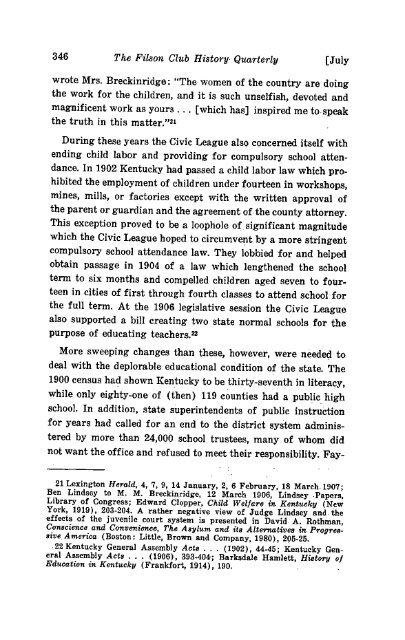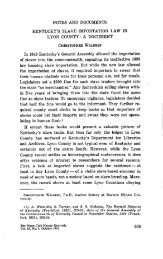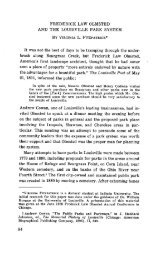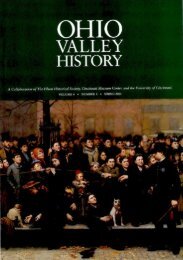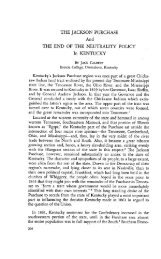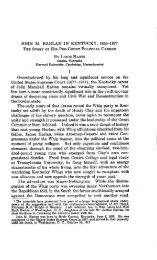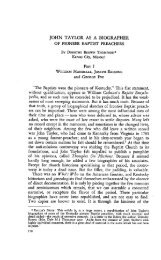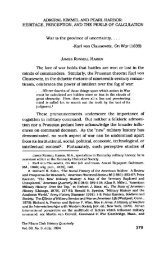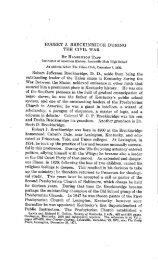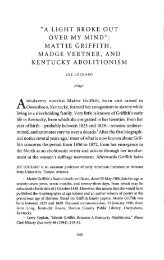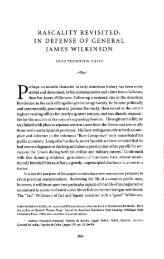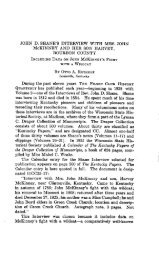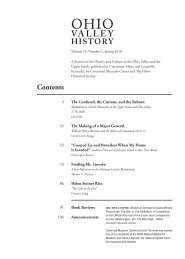The Lexington Civic League: Agent of Reform, 1900 - The Filson ...
The Lexington Civic League: Agent of Reform, 1900 - The Filson ...
The Lexington Civic League: Agent of Reform, 1900 - The Filson ...
Create successful ePaper yourself
Turn your PDF publications into a flip-book with our unique Google optimized e-Paper software.
346 <strong>The</strong> <strong>Filson</strong> Club History. Quarterly [July<br />
wrote Mrs. Breckinridge: "<strong>The</strong> women <strong>of</strong> the country are doing<br />
the work for the children, and it is such unselfish, devoted and<br />
magnificent work as yours... [which has] inspired me to speak<br />
the truth in this matter."21<br />
During these years the <strong>Civic</strong> <strong>League</strong> also concerned itself with<br />
ending child labor and providing for compulsory school atten-<br />
dance. In 1902 Kentucky had passed a child labor law which prohibited<br />
the employment <strong>of</strong> children under fourteen in workshops,<br />
mines, mills, or factories except with the written approval <strong>of</strong><br />
the parent or guardian and the agreement <strong>of</strong> the county attorney.<br />
This exception proved to be a loophole <strong>of</strong> significant magnitude<br />
which the <strong>Civic</strong> <strong>League</strong> hoped to circumvent by a more stringent<br />
compulsory school attendance law. <strong>The</strong>y lobbied for and helped<br />
obtain passage in 1904 <strong>of</strong> a law which lengthened the school<br />
term to six months and compelled children aged seven to fourteen<br />
in cities <strong>of</strong> first through fourth classes to attend school for<br />
the full term. At the 1906 legislative session the <strong>Civic</strong> <strong>League</strong><br />
also supported a bill creating two state normal schools for the<br />
purpose <strong>of</strong> educating teachers.<br />
More sweeping changes than these, however, were needed to<br />
deal with the deplorable educational condition <strong>of</strong> the state. <strong>The</strong><br />
<strong>1900</strong> census had shown Kentucky to be thirty-seventh in literacy,<br />
while only eighty-one <strong>of</strong> (then) 119 counties had a pub!ic high<br />
school. In addition, state superintendents <strong>of</strong> public instruction<br />
for years had called for an end to the district system adminis-<br />
tered by more than 24,000 school trustees, many <strong>of</strong> whom did<br />
not want the <strong>of</strong>fice and refused to meet their responsibility. Fay-<br />
21 <strong>Lexington</strong> Herald, 4, 7, 9, 14 January, 2, 6 February, 18 March. 1907;<br />
Ben Lindsey to M. M. Breekinridge, 12 March 1906, Lindsey .Papers,<br />
Library <strong>of</strong> Congress; Edward Clopper, Child Wel[ars 17 Kentucky (New<br />
York, 1919), 203-204. A rather negative view <strong>of</strong> Judge Lindsey and the<br />
effects <strong>of</strong> the juvenile court system is presented in David A. Rothman,<br />
Censcisnce and Convenience, <strong>The</strong> Asylum and its Alternatives in Progressive<br />
America (Boston: Little, Brown and Company, 1980), 205-25.<br />
22 Kentucky General Assembly Acts . . . (1902), 44-45; Kentucky General<br />
Assembly Acts . . . (1906), 393-404; Barksdale Hamlett, History o/<br />
Education in Kentucky (Frankfort, 1914), 190.


